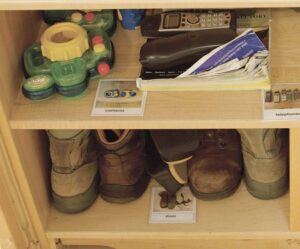Awareness of pictures and print, Expressive language
Toddlers participate in a “word walk” focused on the purposes of print in their room.

Labels and printed signs in your room


[Invite 2–3 toddlers to go on a “word walk” in your room.]
Words are a big part of what we do. We use words when we talk and listen. I am using words right now to talk with you. We use words when we talk with people in our room and with our family.
There are words in our books. People read the words when they share a book with us.
There are words in our room that can help us know where things belong and how things work.
Let’s walk together to find some words that are written in different places in our room.
We can start with some very special words!
[Lead toddlers to their respective cubbies or a location in your room where each toddler’s printed name can be seen.
Why do our cubbies (or other location) have our names?
Follow-up prompt, if needed: How would we know where to put our things if our names were not on our cubbies?
Let’s look for some more words in our room.
 [Walk to another part of the room where one or more printed words are available, such as signs on play centers or locations for storing specific materials. Use the following strategies:
[Walk to another part of the room where one or more printed words are available, such as signs on play centers or locations for storing specific materials. Use the following strategies:
Repeat this process with several more words if toddler interest and time permit.]
We looked at some words in our room. What very special words did we find? (our names) The words can help us do things in our room.
The activity’s focus on printed words supports emerging awareness of the purposes of print. The intent is to help toddlers broaden their concept of the printed word as existing in more than books, and to understand that printed words in a room can tell us how things work. The activity is not intended to teach reading or letters. The current activity extends and refines the broader attention to symbols in a room offered in Block 12.
Look for opportunities to help toddlers connect a printed word to an actual object(s), to a picture that accompanies the printed word, and to the spoken word. These emphases are consistent with the NAEYC accreditation standards for communication/language for very young children, as described in the ELM Curriculum User Guide: Birth–36 Months.
Extra support
Enrichment
Expand the “word walk” to another part of your center, preferably the entryway that toddlers walk through daily.
Awareness of pictures and print, Expressive language
A toddler looks at printed words and pictures in a favorite book with caregiver guidance.



Invite a toddler to join you in looking at a favorite book. Encourage the toddler to hold the book and turn the pages. Read the text. Point to text as you read it. Invite the toddler to describe what is happening in a picture. Then identify a word in the text that describes some aspect of the accompanying picture. Point to the word, say the word, and point to the aspect of the picture that the word describes. Examples: “This word says clock. Here is a clock in our picture.” “This word says jumped. In this picture, a frog jumped into the water. The word tells us what happened.” Use this approach for most pictures in the book. Conclude the session by inviting the toddler to find a picture in the book that he/she really likes. Remind the toddler that a word on this page helped us understand the picture.
Use of a favorite book supports toddler engagement in the activity, including interest in telling what happens in the story. Reduce the amount of text you read if a toddler prefers to be the storyteller. But maintain the suggested procedure of (1) pointing to a word, (2) saying the word, and then (3) connecting the word to the pertinent aspect of the picture. Include words that name an object or character (noun) and words that describe actions shown in a picture (verb) without drawing attention to this distinction.
Extra support
Enrichment
Materials Needed: drawing paper in white or light colors, crayons or markers (without lids) in multiple colors
Place the art materials on a low table. Invite toddlers to draw anything they wish. Offer to write the toddler’s name on their picture and a word that tells what the picture is about. Encourage the toddler to say what word could be put on the art about the picture. Write in the toddler’s presence. Describe what and why you are writing. Example: “I am writing your name here. Now we will know who drew this great picture. I am writing the word ‘mommy.’ You asked me to write the word ‘mommy’ on your picture. Now we know who is in your picture.” Avoid using your writing contribution to teach about letters.
Materials Needed: see activity description
In addition to offering Options 1 and 2 to toddlers, invite preschool-age children to join you in the one-to-one Option 2 activity. Talk about letters if a preschool-age child mentions a letter(s). If a preschool-age child participates in the Interest Area activity, draw attention to the first letter of his/her name when you write it on his/her artwork. Encourage a school-age child to read posted print in your setting for older toddlers and preschool-age children.